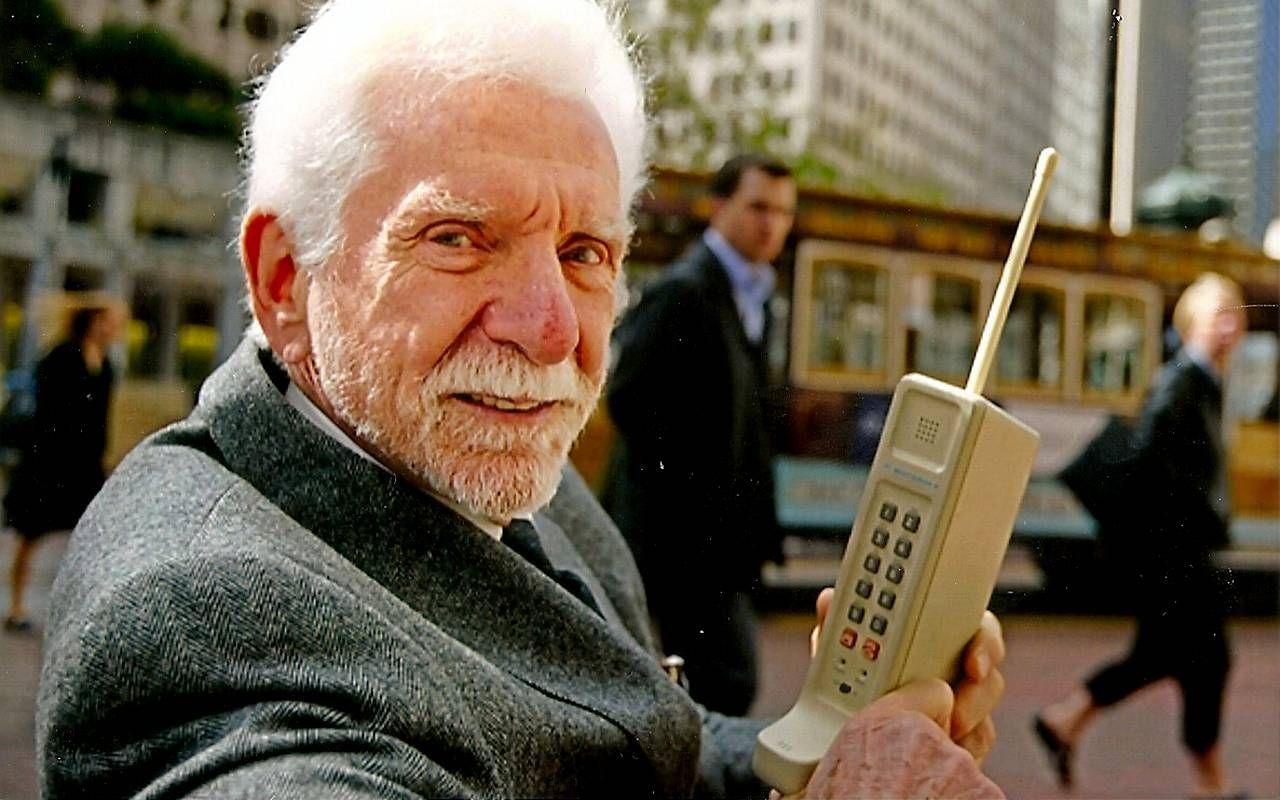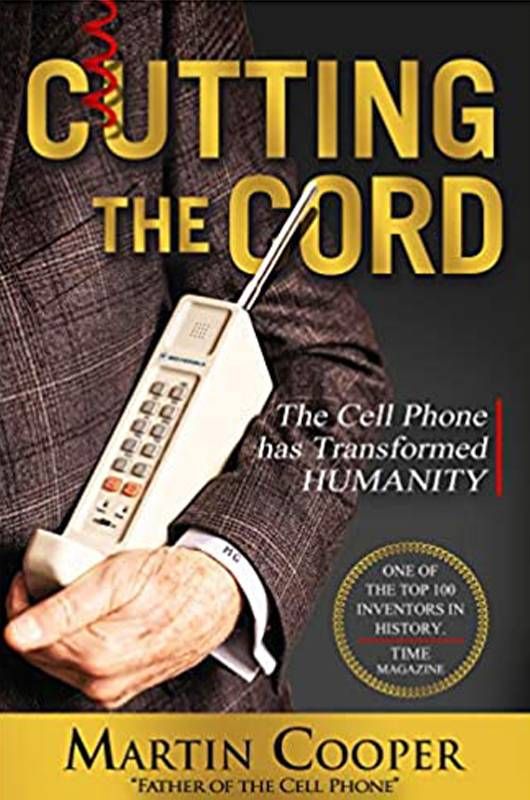The Cell Phone Turns 50
The ubiquitous device seems indispensable to many of us today, but a long time ago in a society far less connected . . .
Marty Cooper remembers standing on a busy sidewalk in Midtown Manhattan on April 3, 1973. He was scheduled to be a guest on a morning TV show to introduce his new product — a wireless cell phone he developed for Motorola.

"They canceled me at the last minute because it wasn't important enough," says Cooper. "So our PR people got a reporter to cover it, and I told them that if we are going to do this kind of thing, let's do it on the sidewalk. We met this guy in front of the Hilton on Sixth Avenue."
Hello . . . Engel?
Cooper realized he hadn't decided whom he would call. So he pulled out his phone book and looked up the number of Joel Engel, an engineer at Bell Labs, where years earlier the company had developed technology for car phones.
"When people saw me holding this phone up, they were stopping on the street."
"Motorola was just a little company in Chicago. At the time, AT&T was considered the best in the world at wired telephones," says Cooper, who is 94. "But we were the best at two-way radios. We understood the freedom, that it is so important for people to be able to be anywhere when they talk, not just wired up or in their cars."
Engel answered his phone, and Cooper explained that he was calling from a cell phone. Engel showed little enthusiasm, but Cooper said, "For us, it was historical. When people saw me holding this phone up, they were stopping on the street."
On a Cellular Level
Motorola debuted the commercial version of Cooper's prototype in 1984. The Motorola Dynatac 8000X, appropriately nicknamed "The Brick", weighed approximately two pounds and had an equally hefty price tag of nearly $4,000.
Today, the average cell phone weighs around 5 ounces, and although some models can be pricey, the cost of a personal cell phone is considerably less than its bulky ancestor.
"All these things contained in a cell phone were just beyond our imagination."
This year, Cooper went back to a New York sidewalk with the original version of the cell phone to commemorate its 50th anniversary. "The same thing happened," he says. "Now there are millions of cell phones, but here's this guy standing on the street with this huge brick. We attracted attention."
Although he had predicted five decades ago that cell phones would be commonplace in the future, Cooper did not anticipate that cell phones would eventually become personal supercomputers. "There were not even personal computers at that time, and there were no digital cameras," he says. "All these things contained in a cell phone were just beyond our imagination."
Innovation for All
Although Cooper is often referred to as "the father of the cell phone," he contributed to other products while working for Motorola and after his career ended. Prior to The Brick, he was involved in creating the first mobile car phone system, and he invented two-way radio pagers for law enforcement and other public service personnel. He was responsible for the traffic light system that adjust traffic signals to optimize traffic flow.
Arlene Harris, Cooper's wife, is an inventor and entrepreneur as well as president and co-founder (with Cooper) of Dyna LLC, an incubator for startups in the field of wireless technology.
"With a Jitterbug phone, you open the phone and listen. If there is a dial tone, you know you have a signal. It was simple — no instruction manual required."
Seeing a need for simplified wireless services for older adults, Harris in 1994 introduced SOS Wireless, a safety phone that gave users one-button access to emergency services. Brands like GreatCall and Jitterbug followed with features that made it even easier for older adults to use wireless technology.
"[Harris] built it from scratch," Cooper says of SOS Wireless. "She and I visited Samsung together, and we persuaded them to build this phone for us. This was the launching pad for GreatCall and the Jitterbug phone."
"You can pick up your cell phone today and the only way you know whether you have a signal is to count the number of bars," he adds. "With a Jitterbug phone, you open the phone and listen. If there is a dial tone, you know you have a signal. It was simple — no instruction manual required. It was comfortable to use, and it was a great success."
Jitterbug is now owned by BestBuy and is a foundation of the company's connected-health program, offering plans with services such as urgent response, on-call nurses and care advocates.
Text and Next
In his book "Cutting the Cord: The Cell Phone has Transformed Humanity," which Cooper dedicated to Harris, he tells of the failures, revelations and even the political ramifications of creating a device that changed how people communicate.
"I tell three different stories," Cooper says. "The first is, what makes a guy an entrepreneur? What makes him have ideas that are counter to what everybody else does? Second, I talk about the wonderful things the cell phone has done in the world today. And then, I talk about the future."
"We're just starting to realize the benefits of this freedom, the access to all the knowledge in the world, the ability to treat people remotely. Those are just starting to become possible after 50 years."
"It is likely that this cell phone revolution has just started now," he continues. "We're just starting to realize the benefits of this freedom, the access to all the knowledge in the world, the ability to treat people remotely. Those are just starting to become possible after 50 years."
In 2010, Cooper was elected to the National Academy of Engineering for his role in the creation of the portable cell phone. He continues to participate in improving and expanding cell phone capabilities.
"To me, the most important thing that's going to happen is what's happening in education. The kids are our future," says Cooper. "They are the ones that have to clean up all the messes that we have created here. I am still an advisor to the FCC, and one of the things I am pushing very hard at is the digital divide.
"Half our students, the people we are depending on for our future, do not have full time access to the internet. And the reason is that they can't afford it, or they live in rural areas where they don't have service. Neither of these is reasonable. There is no reason why carriers can't cover all of our country."
"There are other countries in the world that have much better coverage than we do," he adds. "There is no reason why they can't provide service to students at reasonable prices. I am working very hard to make that happen. There is no doubt in my mind that, when properly educated, our kids can be smarter than we are."
Health Calls

Cooper says that in tandem with better connection for education, cell phones can promote better health. By offering personal health service, Cooper says, it could be possible to have physical exams within minutes, instead of waiting to receive an annual exam from a doctor.
"A stroke doesn't wait a year. [Wireless health care] is very possible — in fact, it will happen. It is only a question of when," says Cooper. "Every disease will be covered. Because we can anticipate the disease. We can measure your body and the disease that is happening before it has really taken hold, before it depletes your immune system, and you can cure diseases before they happen. I think a few generations from now, there will no longer be disease, because we will be connected all the time. Before you get sick, something is going to make you better."
Cooper encourages people of all ages to take charge of their own health, to continue learning and to be open and excited about possibility.
"If you keep learning, you don't lose the ability to learn," he says. "Keep moving, keep thinking, be curious and learn — for the rest of your life."
The world in your hand
The Smithsonian Institution's Museum of Natural History in Washington is preparing a temporary exhibit titled "Cell Phone: Unseen Connections." The exhibition will include interactive group chats and multimedia installations that explore how the cell phone has revolutionized the way people connect on personal, business, cultural and technological levels.


